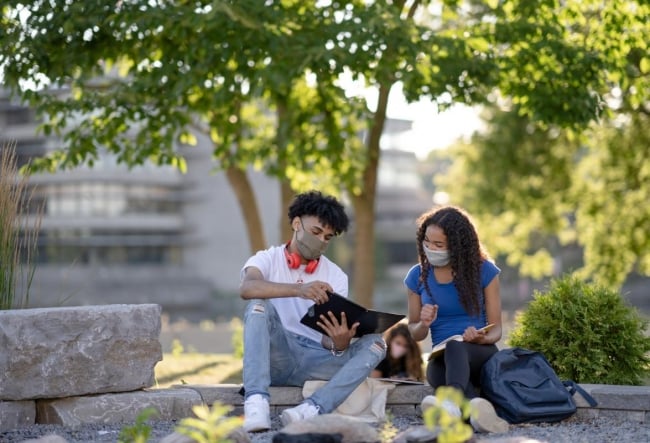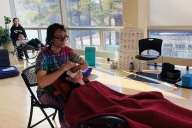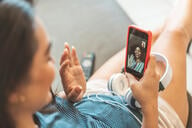You have /5 articles left.
Sign up for a free account or log in.

FatCamera/E+/Getty Images
More than a year and a half into the COVID-19 pandemic, with many college campuses back at normal capacity, student health centers are feeling the pressure.
There is increased demand for routine health services now that students are back on campus, and they’re also seeking more mental health care. The health centers are having difficulty hiring in a competitive health-care labor market, and staff members are overworked and fatigued. There is plenty of stress to go around.
“Our campus is fully in-person, as many are this year, and so for many students they’ve also had to delay care for health-care problems because so many things were shut down last year,” said Cheryl Hug-English, medical director for the Student Health Center at the University of Nevada at Reno. “We’re catching up with a lot of health-care concerns, both physical and mental health-care concerns, in addition to handling all of the visits for COVID concerns.”
“Even if you took COVID out of the picture, our visit numbers would be up, but then you add COVID testing and COVID vaccination, and for our campus it’s certainly more than double what our norm would be,” Hug-English said.
Student health directors across different campuses point to common challenges.
“The challenge that our college health centers are facing is people have been through really an exhausting period of 18 months,” said Sarah Van Orman, chief health officer for University of Southern California Student Health. “Now we’re back and all the normal things we do are still there -- normal numbers of illnesses and injuries -- but many of the COVID-related responsibilities are still there.”
Like Hug-English, Van Orman described a “pent-up demand for services” from students who delayed care or were not on campus last year to access preventative services, with that pent-up demand coming on top of ongoing needs related to COVID testing and management of COVID cases. Students with cold-like symptoms who might have self-treated before the pandemic now are seeking out professional medical care and testing to rule out COVID. And the number of students on campuses for the first time is about double the normal number on many campuses -- many second-year students studied remotely during the last academic year -- requiring staff members to do more vaccine verifications (for COVID and otherwise) and conduct more health screenings of incoming international students.
“Each of these by themselves are manageable,” Van Orman said, “but when you put it all together, coming on top of a workforce that’s been working really hard for 18 months, it is challenging.”
Worker shortages and high attrition in the health-care workforce have also not helped matters.
“Another thing I’m hearing from many colleagues is there’s a health-care worker shortage in their community and it’s very difficult to recruit and retain health-care workers because of the demand within the local community,” she said.
Rachel Mack, a spokeswoman for the American College Health Association, said members cited staff burnout, staff shortages and a “business-as-usual attitude” as their top concerns in a recent survey.
“Generally speaking, I think it’s fair to say that college health is experiencing similar issues as traditional health care right now, but with some different challenges,” Mack said via email. “More work, same or fewer employees (IHEs are seeing a large exodus) and a large percentage of students on campus for the first time … Mental health needs, already high in this population, have increased.”
“Every year I have been in college health, it seems that each new year has increased demand for services,” said M. Scott Tims, assistant vice president for student health at Tulane University in New Orleans. “I think what makes this year unique in this regard is the overlay of having been in a pandemic for a long time and the stress of that. We’re seeing a significant mental health load, which again is not unusual, but I also think it’s a little different than the typical transition issues that we see. These are folks who are struggling with a fear of COVID, folks who have missed out on their junior and senior year of high school.”
Jake Baggott, associate vice chancellor and executive director of University Health Services at the University of Wisconsin at Madison, said there is at least a 20 percent increase in mental health visits this fall compared to last year, building on what was already a 6 percent increase in demand for mental health services from academic year 2019-20 to 2020-21.
“The mental health-care needs are giant,” said Tara Girard, associate dean of students for recreation, wellness and engagement at Beloit College, a small liberal arts college in Wisconsin, and acting director for Beloit’s Health and Wellness Center, a position she previously held for about seven and a half years. With about 900 students on Beloit’s campus this year compared to about 600 last fall, she described the demand for health-care services in general this fall as “outrageous.”
“For the most part, people stayed home when they were sick last year, and on top of that, flu season was almost nonexistent,” Girard said. “On campus we were wearing masks indoors and out. We had fewer people on campus. Most students were in singles. Everyone was on high alert for passing germs around. In addition, people weren’t seeking care for routine things. Now everyone is back in full force, seeking health care again.”
On top of her many responsibilities Girard, a registered nurse, sits on Beloit’s COVID task force and also helps set collegewide policies on COVID.
“Every COVID question comes to me,” she said. “It’s definitely felt like a 7-day-a-week, 24-hour-a-day job for about a year and a half.”
Kathleen Pridgen, associate director for medical services at the University of Alabama at Birmingham, said, “What’s made this fall really tough is it seems like everyone is ready to re-engage with their routine medical care, but also when we started the semester, there was a surge in a lot of parts of the country. So there was all the makeup care in addition to a lot of COVID-related care as far as visits and testing. The COVID wasn’t any slower than it was at points last year, but the general medical stuff was busier.”
Pridgen said COVID takes a lot of bandwidth. “There are obviously issues of patients that are sick that need immediate attention, but also on the less acute side of things, COVID creates an enormous amount of questions,” she said. “It clogs the phone lines. It clogs up the [online] portals. It’s just constant questions of, ‘Can I go to class?’ ‘Do I need a test?’ ‘Do I not need a test?’ ‘When do I test?’”
Middle Tennessee State University experienced a spike in COVID cases this fall with more students on campus this year than last year and with few mitigation measures in the surrounding community, said Richard Chapman, director of student health services. The university has an indoor mask mandate, but the surrounding community does not.
“The lack of masking and social distancing in the community has driven our spike in cases,” said Chapman.
Middle Tennessee is not mandating COVID vaccination, but the university is tracking vaccination rates.
“We’ve seen a steady increase from low 40s among students to above 50 percent among students currently and above 70 percent for our faculty and staff,” Chapman said. “Obviously, to get the population vaccinated is the best way out of all this.”
Lisa Schrader, Middle Tennessee’s director of health promotion, said of the ongoing vaccination efforts, “It’s very much now you’re making progress one person at a time.”
Schrader recalled last winter and spring, when vaccination efforts began.
“That was our first real feeling of hope that we could see our way out of the tunnel we’d been living in, so there was a lot of excitement and rejuvenation in those months,” she said. “To fast-forward into the summer and fall, how the Delta variant has now caused these spikes again and how even vaccinated people are experiencing breakthrough infections -- it’s a shot in the gut to not feel like you know when you’re going to come out of it.”




